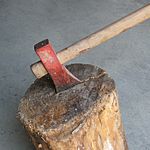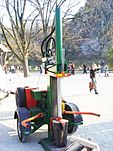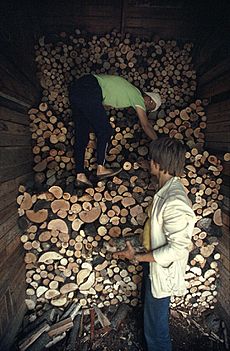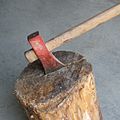Firewood facts for kids
Firewood is any wooden material that is gathered and used for fuel. Generally, firewood is not highly processed and is in some sort of log or branch form.
Contents
Preparing
In most parts of the world, firewood is only prepared for transport at the time it is harvested. Then it is moved closer to the place it will be used as fuel and prepared there. The process of making charcoal from firewood can take place at the place the firewood is harvested.
Most firewood also requires splitting, which also allows for faster seasoning by exposing more surface area. Today most splitting is done with a hydraulic splitting machine, but it can also be split with a splitting maul. More unusual, and dangerous, is a tapered screw-style design, that augers into the wood, splitting it, and can be powered by either a power take-off drive, a dedicated internal combustion engine, or a rugged electric pipe-threading machine, which is safer than the other power sources because the power can be shut off more easily if necessary. Another method is to use a kinetic log splitter, which uses a rack and pinion system powered by a small motor and a large flywheel used for energy storage.
Storing
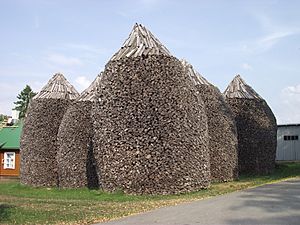

There are many ways to store firewood. These range from simple piles to free-standing stacks, to specialized structures. Usually the goal of storing wood is to keep water away from it and to continue the drying process.
Stacks: The simplest stack is where logs are placed next to and on top of each other, forming a line the width of the logs. The height of the stack can vary, generally depending upon how the ends are constructed. Without constructing ends, the length of the log and length of the pile help determine the height of a free-standing stack.
There is debate about whether wood will dry more quickly when covered. There is a trade-off between the surface of the wood getting wet vs. allowing as much wind and sun as possible to access the stack. A cover can be almost any material that sheds water – a large piece of plywood, sheet metal, terracotta tiles, or an oiled canvas cloth, even cheap plastic sheeting may also be used. Wood will not dry when completely covered. Ideally pallets or scrap wood should be used to raise the wood from the ground, reducing rot and increasing air flow.
There are many ways to create the ends of a stack. In some areas, a crib end is created by alternating pairs of logs to help stabilize the end. A stake or pole placed in the ground is another way to end the pile. A series of stacked logs at the end, each with a cord tied to it and the free end of the cord wrapped to log in the middle of the pile, is another way.
Under a roof: Under a roof, there are no concerns about the wood being subjected to rain, snow or run-off, but ventilation needs to be provided if the wood is stored green so that moisture released from the wood does not recondense inside. The methods for stacking depend on the structure and layout desired. Whether split, or in 'rounds' (flush-cut and unsplit segments of logs), the wood should be stacked lengthwise, which is the most stable and practical method. Again though, if the wood needs further seasoning there should be adequate air flow through the stack.
Storing outdoors: Firewood should be stacked with the bark facing upwards. This allows the water to drain off, and standing frost, ice, or snow to be kept from the wood.
Round stacks can be made many ways. Some are piles of wood with a stacked circular wall around them. Others like the American Holz Hausen are more complicated.
- A Holz hausen, or "wood house", is a circular method of stacking wood; proponents say it speeds up drying on a relatively small footprint. A traditional holz hausen has a 10-foot diameter, stands 10 feet high, and holds about 6 cords of wood. The walls are made of pieces arranged radially, and tilted slightly inward for stability. The inside pieces are stacked on end to form a chimney for air flow. The top pieces are tilted slightly outward to shed rain and are placed bark side up.
Images for kids
-
Stack of split firewood and a maul for splitting, Czech Republic
-
Birch embers on sauna stove.
-
Firewood collector in Mozambique
See also
 In Spanish: Leña para niños
In Spanish: Leña para niños


